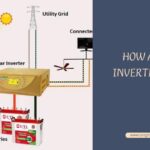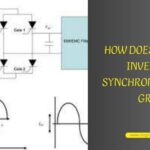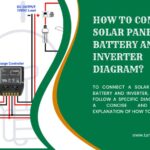How Does Solar Inverter Work?
How Does Solar Inverter Work? converts the direct current (DC) produced by solar panels into alternating current (AC), which is usable for powering electrical devices. Solar inverters play a crucial role in solar power systems by ensuring that the energy generated from the sun can be effectively utilized.
When sunlight hits the solar panels, it produces DC electricity. However, most appliances and the power grid operate on AC electricity. This is where the solar inverter comes in. It converts the DC power from the solar panels into AC power that can be used to run household appliances or fed back into the grid.
By efficiently transforming the type of electricity produced, solar inverters enable the seamless integration of solar energy into our daily lives and contribute to reducing our reliance on traditional power sources.
Understanding Solar Inverter Basics
A solar inverter is a crucial component of any solar energy system. It is crucial to convert the direct current (DC) power that solar panels produce into alternating current (AC) power that can power our homes and businesses. Solar panel power wouldn’t be usable without a solar inverter.
How Does a Solar Inverter Synchronize With Grid
Functionality And Role Of Solar Inverters
Solar inverters serve as the bridge between the DC power generated by solar panels and the AC power required for our daily electricity needs. Their primary function is to convert the DC power into AC power, ensuring compatibility with standard appliances and the power grid.
Furthermore, solar inverters have an additional role in monitoring the performance of the solar energy system. They collect data, such as the amount of energy produced, system status, and any faults or errors that may occur. This data helps users and technicians troubleshoot issues and optimize the system’s performance.
Key Components Of A Solar Inverter System
A solar inverter system consists of several key components that work together to ensure smooth and efficient energy conversion:
- DC-to-AC inverter: The main component responsible for converting DC power into AC power.
- Maximum Power Point Tracker (MPPT): It optimizes the power output of the solar panels by tracking the maximum power point, ensuring the highest efficiency.
- Transformer: Provides electrical isolation and voltage regulation, keeping the AC power at the desired voltage level.
- Cooling system: Inverters generate heat during operation, and a cooling system helps dissipate the heat, preventing damage to the components.
- Monitoring system: This component collects and provides data on the system’s performance, displaying important metrics such as energy production and system health.
How Solar Inverters Convert DC to AC Power
Solar inverters employ a complex process to convert DC power to AC power. Let’s explore the simplified steps involved:
- Solar panels harness sunlight and convert it into DC power.
- The DC power from the solar panels is sent to the solar inverter.
- The maximum power point tracker (MPPT) optimizes the DC power output from the solar panels.
- The DC power is then converted into a stable AC power waveform suitable for consumption by electrical devices.
- The AC power can be used to power appliances, sent to the electrical grid, or stored in batteries, depending on the specific energy system setup.
Importance Of Solar Inverters In A Solar Energy System
Solar inverters are indispensable in a solar energy system due to their significant role in enabling the conversion and utilization of solar power. Here are a few reasons why solar inverters are crucial:
- Solar inverters ensure that the DC power generated by solar panels is converted into AC power, making it compatible with standard appliances and the electrical grid.
- They facilitate efficient energy use and reduce dependence on traditional energy sources, leading to lower electricity bills and a greener environment.
- Monitoring capabilities of solar inverters help users identify and resolve issues promptly, maximizing energy production and system longevity.
- Their integration with smart grid technologies enables two-way communication, allowing solar energy systems to supply power back to the grid, promoting energy sharing and resilience.
Types Of Solar Inverters
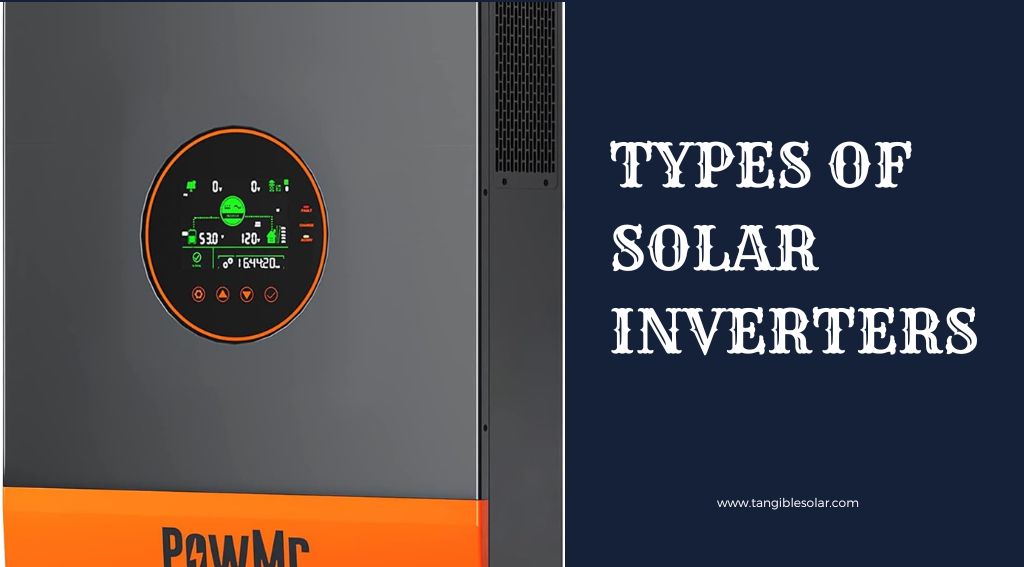
Solar inverters are an essential component of any solar power system. They convert the direct current (DC) electricity generated by solar panels into the alternating current (AC) electricity required for use in homes and businesses. There are several types of solar inverters available, each with its own advantages and disadvantages. Understanding the different types can help you choose the most suitable inverter for your specific needs.
Different Types Of Solar Inverters Available
The following table provides an overview of the most common types of solar inverters:
| Type of Solar Inverter | Description |
| String Inverter | These inverters are the most common and cost-effective option. They connect multiple solar panels in series to form a string, which is then connected to the inverter. String inverters are suitable for residential and small commercial installations. |
| Microinverter | Unlike string inverters, microinverters are installed on each individual solar panel. This allows for maximum power output, as shading or malfunctions in one panel do not affect the others. Microinverters are ideal for installations with complex roof layouts or shading issues. |
| Hybrid Inverter | Hybrid inverters combine the functionality of a solar inverter with a battery storage system. They allow you to store excess solar energy generated during the day and use it during periods of low or no sunlight. Hybrid inverters are suitable for both grid-tied and off-grid systems. |
| Grid-Tie Inverter | Grid tie inverters are designed to synchronize your solar power system with the utility grid. They allow you to feed excess electricity back into the grid, reducing your dependency on grid power and potentially earning credits or payments from your utility company. |
Pros And Cons Of Each Type
Here are the pros and cons of each type of solar inverter:
- String Inverter: The main advantage of string inverters is their cost-effectiveness. However, shading or malfunctions in one panel can affect the performance of the entire string.
- Microinverter: Microinverters offer the highest power output and are unaffected by shading or problems with individual panels. However, they have a higher upfront cost compared to string inverters.
- Hybrid Inverter: Hybrid inverters allow for energy storage, reducing your reliance on the grid. However, they come with a higher initial investment and require proper battery maintenance.
- Grid Tie Inverter: Grid tie inverters enable you to offset your energy consumption and potentially earn credits or payments. However, they do not provide backup power during grid outages.
Which Type Of Solar Inverter Is Most Suitable For Your Needs
Choosing the most suitable solar inverter work for your needs depends on various factors, such as your budget, roof layout, shading issues, and energy storage requirements. If your installation site has shading problems or a complex roof layout, microinverters may be the best choice. On the other hand, if you are looking for a cost-effective solution, string inverters may be more suitable. Considerations When Choosing a Solar Inverter When selecting a solar inverter, there are a few key considerations to keep in mind:
- System Size: Ensure that the inverter you choose can handle the electrical capacity of your solar power system.
- Efficiency: Look for inverters with high-efficiency ratings to maximize the electricity generated by your solar panels.
- Warranty: Check the warranty period and terms offered by the manufacturer to protect your investment.
- Monitoring Capabilities: Consider inverters that offer real-time monitoring options, allowing you to track your system’s performance and identify any issues quickly.
- Compatibility: Ensure that the inverter is compatible with your solar panels and other system components.
By considering these factors and understanding the pros and cons of each type of solar inverter, you can make an informed decision and choose the most suitable option for your specific needs. Remember to consult with a professional solar installer to ensure the optimal performance of your solar power system.
Solar Inverter Working Principle
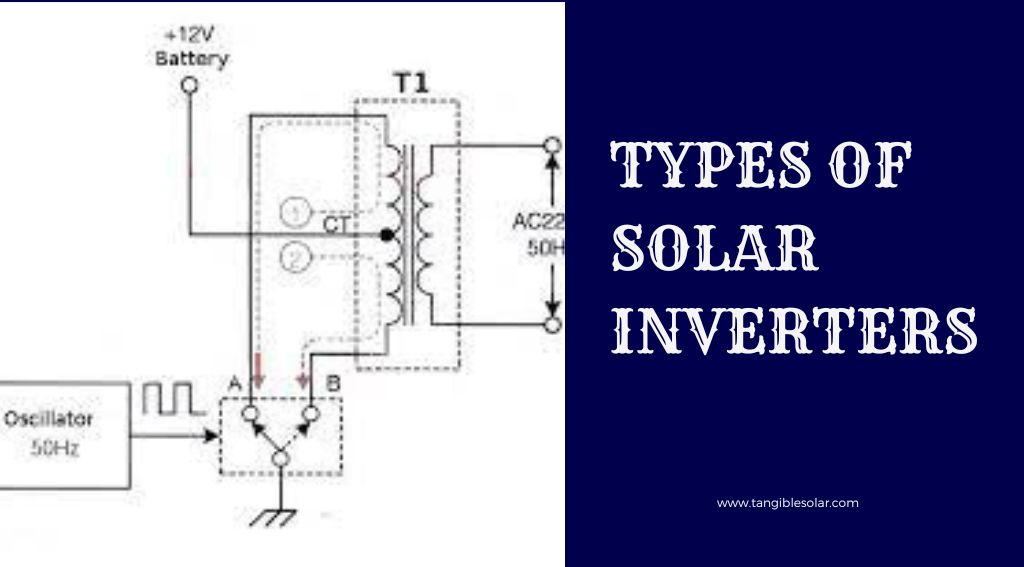
Detailed Explanation Of How Solar Inverters Work
Solar inverters play a crucial role in the functioning of a solar energy system. They convert the direct current (DC) electricity generated by solar panels into alternating current (AC) electricity that can be used to power appliances and devices. The solar inverter working principle involves several steps to ensure efficient and safe energy conversion. Firstly, when sunlight falls on the solar panels, they produce DC electricity. Solar inverters accomplish this conversion by utilizing advanced electronic components and control systems.
The Role Of Mppt (Maximum Power Point Tracking)
One crucial aspect of solar inverter work functioning is Maximum Power Point Tracking (MPPT). It continuously monitors the output of the solar panels and adjusts the inverter’s operating conditions to extract the maximum power available. By tracking the maximum power point of the panels, MPPT ensures that the solar inverter operates at its most efficient level, maximizing the electricity generated from the solar energy system.
Conversion Process From DC to AC Power
Once MPPT has determined the optimal operating conditions, the solar inverter begins the conversion process from DC to AC power. This process involves several stages: 1. Rectification: The solar inverter first rectifies the DC power from the solar panels, converting it from pulsating DC to a constant DC voltage. This rectification is necessary to ensure stable and reliable power conversion. 2. The inverter circuit contains a series of switches that convert the DC voltage into AC voltage. These switches rapidly switch on and off, creating a modified AC waveform that closely resembles the standard sinusoidal waveform of grid electricity. 3. This system eliminates any harmonics or noise present in the waveform, ensuring a clean and smooth AC output.
Solar Inverter Efficiency And Performance
Understanding the efficiency ratings of solar inverters is crucial when it comes to maximizing the overall performance of your solar power system. Solar inverters play an integral role in converting the direct current (DC) generated by solar panels into usable alternating current (AC) for your home or business. The efficiency of an inverter determines how effectively it performs this conversion process, ultimately impacting the overall output of your solar system.
How to Connect Solar Panel Inverter And Battery
Understanding Efficiency Ratings Of Solar Inverters
The efficiency of a solar inverter work is measured by its ability to convert DC power from solar panels into AC power that can be used to power appliances and devices. Higher efficiency ratings indicate that the inverter can convert a larger proportion of the DC power it receives into usable AC power.
Factors Affecting The Efficiency Of Solar Inverters
Several factors can influence the efficiency of a solar inverter:
- Input voltage range: The input voltage range of an inverter determines its ability to operate efficiently under varying solar panel voltages. Inverters with a wide input voltage range are more likely to maintain high efficiency across different solar conditions.
- Temperature: The operating temperature of an inverter can impact its efficiency. Higher temperatures can lead to a decrease in efficiency, so it is important to consider the ambient temperature of the installation location.
- Load capacity: The load capacity of an inverter refers to its ability to handle the power demands of connected devices. Inverters that are operating near their maximum load capacity may experience reduced efficiency.
Impact Of Inverter Efficiency On Overall System Performance
The efficiency of a solar inverter has a direct impact on the overall performance of your solar power system. A low-efficiency inverter can result in power losses during the conversion process, leading to decreased energy production.
Furthermore, inefficient inverters can generate excess heat, which can reduce their lifespan and potentially lead to performance issues over time. By selecting a high-efficiency solar inverter, you can ensure that your system operates optimally, maximizing energy production and reducing the risk of long-term issues.
Importance Of Selecting A High-efficiency Solar Inverter
When choosing a solar inverter, it is crucial to prioritize high efficiency. By selecting a high-efficiency inverter, you can:
- Maximize energy production: High-efficiency inverters can convert a larger proportion of the solar panel’s DC power into usable AC power, increasing the overall energy production of your system.
- Optimize return on investment: With a more efficient inverter, you can take full advantage of your solar panel’s potential, maximizing the return on your investment in solar energy.
- Enhance system reliability: High-efficiency inverters generate less heat, which can improve their reliability and lifespan, minimizing the risk of performance issues in the long run.
Troubleshooting And Maintenance Of Solar Inverters
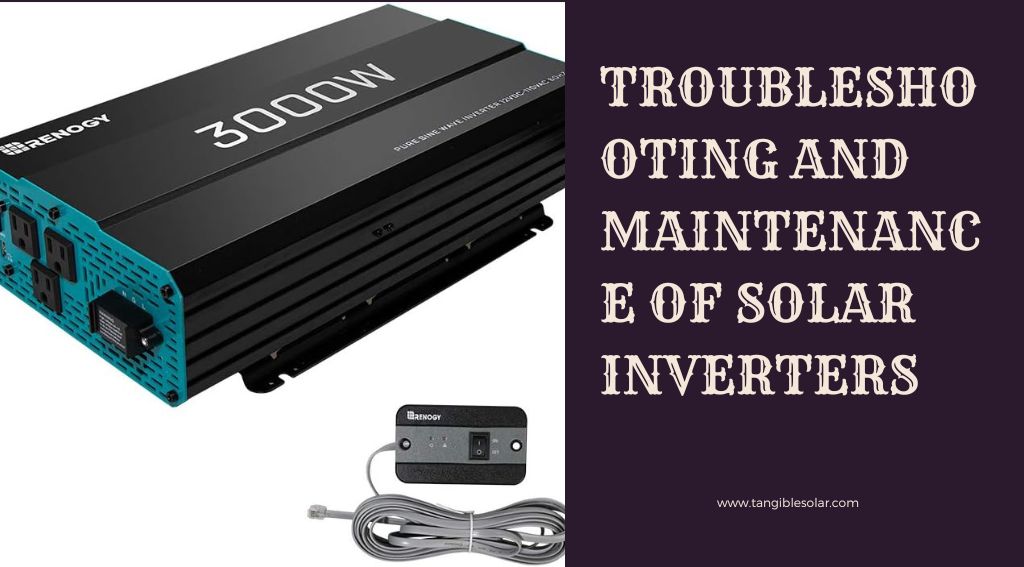
Common Issues And Problems With Solar Inverters
Understanding the common issues and problems that can occur with solar inverters is the first step in troubleshooting and addressing any faults. Some of the most common issues include:
- No power output: If your solar inverter work is not producing any power output, it could indicate a problem with the inverter or the solar panels themselves. Troubleshooting this issue involves checking the connection between the inverter and solar panels, as well as inspecting the panels for any damage or obstructions.
- Low power output: If your solar inverter is producing lower power output than expected, it could be due to shading, dirt or debris on the panels, or a fault in the inverter itself. Conducting a visual inspection of the panels and cleaning them if necessary can often resolve this issue.
- Inverter display errors: Inverter display errors can indicate various issues, including communication errors, voltage abnormalities, or internal faults. These errors are usually accompanied by error codes or messages on the display. Referring to the manufacturer’s manual or contacting a professional can help identify the specific issue and take appropriate action.
- Inverter overheating: Overheating is a common problem in solar inverters, especially in areas with high temperatures or insufficient ventilation. It can lead to reduced efficiency and even complete system shutdown. Regularly checking the inverter’s temperature and ensuring proper airflow around the unit can prevent overheating issues.
How Many Solar Panels for 3000 Watt Inverter
Diagnosing And Troubleshooting Inverter Faults
Diagnosing and troubleshooting inverter faults requires a systematic approach to identifying the root cause of the issue. Here are some steps you can follow:
- Check the connections: Start by inspecting the relations between the solar panels, inverter, and the utility grid. Loose or corroded connections can result in power loss or other issues.
- Review error codes: If your inverter displays error codes or messages, refer to the manufacturer’s manual or online resources to understand the meaning behind these codes. This can provide valuable insights into the specific fault or issue.
- Verify solar panel performance: Ensure that your solar panels are functioning optimally by visually inspecting them for damage, dirt, or shading. If necessary, clean the panels or remove any obstructions to maximize their performance.
- Consult a professional: If you are unable to diagnose or address the inverter fault, it is recommended to consult a professional solar technician. They have the expertise and diagnostic tools to identify and resolve complex issues efficiently.
Regular Maintenance And Inspections For Optimal Performance
Regular maintenance and inspections are key to ensuring the optimal performance and longevity of your solar inverter. Here are some maintenance tips to follow:
- Keep the inverter clean: Regularly clean its external surfaces, ensuring it is free from dust and debris. Use a soft cloth or brush to gently remove any dirt that may accumulate over time.
- Monitor performance: Keep an eye on your inverter’s performance by regularly checking the power output, voltage, and any error messages. This can help you identify any potential issues early on.
- Inspect the wiring: Periodically inspect the wiring connections between the inverter, solar panels, and the utility grid. Look for any signs of wear, loose connections, or corrosion, and address them promptly.
- Ensure proper ventilation: Ensure that the inverter has sufficient ventilation to prevent overheating. Keep the area around the inverter clear of any obstructions and consider installing a fan or additional ventilation if necessary.
Extending The Lifespan Of Your Solar Inverter
Extending the lifespan of your solar inverter can help maximize your return on investment and ensure consistent energy production. Here are some tips to keep in mind:
- Follow manufacturer’s guidelines: Always adhere to the manufacturer’s guidelines regarding installation, operation, and maintenance of the inverter. This can help prevent unnecessary faults and ensure optimal performance.
- Invest in quality: Choose a reliable and high-quality solar inverter from a reputable manufacturer. Quality inverters tend to have better longevity and performance compared to cheaper alternatives.
- Schedule professional inspections: Consider scheduling regular inspections and maintenance visits from professional solar technicians. They can perform thorough checks, identify potential issues, and undertake preventive measures to extend your inverter’s lifespan.
- Protect against environmental factors: Shield your inverter from extreme weather conditions, such as excessive heat or moisture. If necessary, install protective enclosures or covers to safeguard the inverter against environmental factors.
Frequently Asked Questions Of How Does Solar Inverter Work
How Does A Solar Inverter Work?
A solar inverter converts the direct current (DC) generated by solar panels into alternating current (AC) used to power homes and businesses. The inverter also monitors the grid voltage to ensure a stable power supply and synchronizes the solar power with the grid.
What Is The Role Of A Solar Inverter In A Solar Power System?
The solar inverter plays a crucial role in a solar power system. It converts the DC electricity generated by the solar panels into AC electricity, which is compatible with the standard electricity grid. This enables your home or business to use the solar energy you produce and reduces reliance on fossil fuels.
The inverter also provides important safety features and monitoring capabilities.
Can A Solar Inverter Work Without Sunlight?
No, solar inverters need sunlight to function. Since solar panels generate electricity from sunlight, without sunlight, there will be no solar energy to convert from DC to AC. However, certain types of inverters, such as hybrid inverters, can work with battery storage systems to provide power during nighttime or low sunlight conditions by utilizing stored energy.
What Happens To Excess Solar Energy Not Used By The Home?
When solar panels generate more energy than the home or business consumes, the excess electricity flows back into the grid through the solar inverter.
Therefore, during sunny days, your solar panels can actually help offset your energy consumption in times when your panels aren’t producing as much energy, such as cloudy days or nighttime
Conclusion
Understanding how solar inverter work is vital for harnessing the power of solar energy. By converting the direct current (DC) generated by solar panels into alternating current (AC) usable in our homes and businesses, solar inverters play a crucial role in the solar energy system.
With their efficiency and ability to seamlessly integrate with the electrical grid, solar inverters have become an integral part of the renewable energy revolution. Embracing this technology allows us to reduce our reliance on fossil fuels, lower our carbon footprint, and pave the way for a sustainable future.

